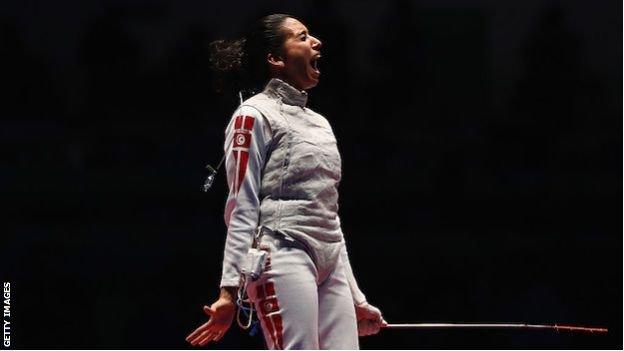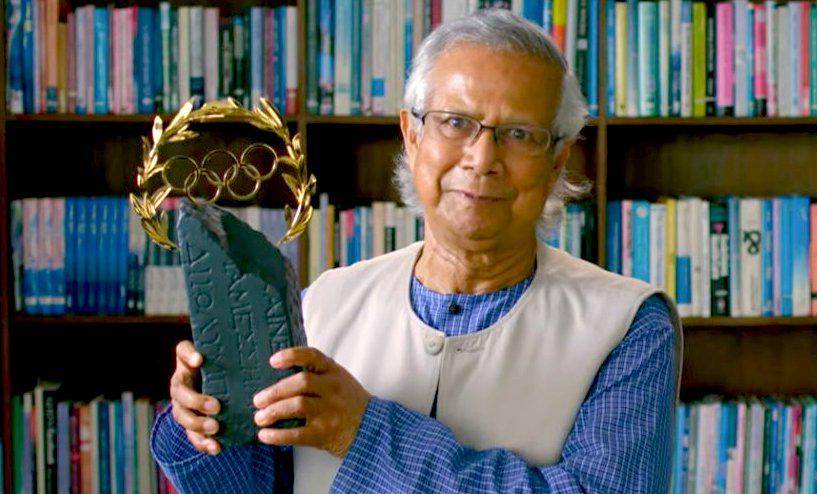By BETH HARRIS

1 of 4
TOKYO (AP) — Nobody was watching Ahmed Hafnaoui in lane eight of the Olympic pool.
All eyes were on the Tunisian teenager at the finish.
Hafnaoui was the stunning winner of the 400-meter freestyle at the Tokyo Games on Sunday, beating a field of faster and older swimmers. The 18-year-old finished in 3 minutes, 43.26 seconds, punctuating his victory with loud yelling that echoed in the mostly empty 15,000-seat arena.
“I believe when I touched the wall and I saw myself first,” he said. “I was so surprised.”
Australia’s Jack McLoughlin earned silver and American Kieran Smith took bronze. The top three were separated by less than a second after the eight-lap race.
“When I hit the water, I was just thinking about the medal, not the time,” Hafnaoui said.
He squeaked into the final by 14-hundredths of a second, landing him in the far outside lane. The fastest qualifiers were in the middle of the pool, without the ability to track Hafnaoui during the race.
Asked what he knew about Hafnaoui, Smith said, “Absolutely nothing.”
Hafnaoui made sure he’ll be remembered with a performance that boosted his resume considerably.
He joined Ous Mellouli as the only Tunisians to win a gold in swimming. Mellouli won the 1,500 freestyle at the 2008 Beijing Games, one of his three career Olympic medals. He reached out with a good-luck message to the teenager before the race.
“I wish to be like him one day,” Hafnaoui said.
The teen who trains in the capital of Tunis is the North Africa country’s fourth Olympic gold medalist. He’s the second-youngest athlete from an African nation to win a swimming gold; Joan Harrison of South Africa was 16 when she won the 100 backstroke at the 1952 Helsinki Games.
Standing on the podium, his coach furiously pumping his arms in triumph in the stands, the moment was overwhelming for Hafnaoui.
“I was in tears because when I see the flag of my country and I hear the anthem in the background, it was great,” he said. “I’m so proud of it. I dedicate it to all the Tunisian people.”
Hafnaoui began swimming at age 6 when his father enrolled him in a swim club. His limited international experience includes an eighth-place finish in the 400 free at the 2018 Youth Olympics.
“The best people are the ones who can come up and swim their best times at the Olympic Games,” McLoughlin said.
Hafnaoui has another chance to pull off a surprise when he competes in the 800 free on Thursday. Next year, he said he plans to attend college in the U.S.
___
More AP Olympic coverage: https://www.apnews.com/OlympicGames and https://twitter.com/AP_Sports
Tokyo 2020: Shock swimming gold for Japan and Tunisia
Updated / Sunday, 25 Jul 2021

Tunisia and Japan celebrated unexpected golds on the opening day of swimming medal events before normal service was resumed with the Australian women's 4x100m freestyle relay team smashing their own world record on the way to the title in Tokyo.
Chase Kalisz settled American nerves by delivering the country's first gold of these Games, winning the men's 400m medley as part of a US one-two with Jay Litherland.
On a day of surprises, Tunisian teenager Ahmed Hafnaoui pulled off the biggest shock of all with a stunning victory in the men's 400m freestyle.
The 18-year-old, swimming in the outside lane as the slowest qualifier, produced a blistering finish to pip Australia's Jack McLoughlin to gold with a time of 3:43.36, with American Kieran Smith taking bronze.
Hafnaoui's gold is only the fifth by a Tunisian athlete at the Olympics, but their third in swimming, and he was left stunned by his performance.
"I just can't believe it. It's a dream and it became true. It was great. it was my best race ever," he said.
While Hafnaoui's coach celebrated the victory by leaping around the edge of the pool, it was hard not to wonder what the scenes would have been like had Yui Ohashi's victory in the women's 400m medley come in front of a home crowd.
It was left to her team mates and Japanese officials to roar her home as she delivered gold for the hosts in a time of 4:32.08.
"It doesn't feel real. It is like a dream for me," she said.
"I couldn’t go to the Rio Olympics, so for the past five years this became a big dream for me. This accomplishment is amazing."

American Emma Weyant took the silver medal 0.68 behind and compatriot Hali Flickinger picked up the bronze.
Ohashi pulled away from Flickinger in the breaststroke leg and went into the freestyle with a lead of 1.99 seconds, giving her a comfortable cushion to hold off Weyant's late surge.
Hungarian Katinka Hosszu, who has dominated the event in recent years and was defending champion, could finish only fifth.
The 32-year-old 'Iron Lady' was looking to become the second-oldest women’s swimming gold medallist in history, behind American Dara Torres, and she has three more chances in this Games.
In the men's 400m medley, a confident Kalisz powered to victory as the Americans finally made their presence felt.
The silver medallist from Rio went one better in Tokyo with a time of 4:09.42, Litherland trailing him home 0.86 behind. Australia's Brendon Smith was a further tenth of a second back taking bronze.
Kalisz, 27, grabbed the lead on the first length of the backstroke after France's Leon Marchand had led after the butterfly leg and never looked back.
He battled with New Zealand's Lewis Clareburt through the breaststroke but the Kiwi faded badly in the freestyle and finished seventh.
"It means the world. This is the last thing that I really wanted to accomplish in my swimming career," said Kalisz.
"It was something that was a dream of mine for as long as I could remember. I can't believe it."
Japan's Daiya Seto, the pre-Games favourite for gold, had failed to qualify from Saturday's heats.
While it was a disappointing day for Australia in the men's events, the women set a world record of 3:29.69 in the 4x100m freestyle relay, with Canada taking silver, 3:09 behind the winners, and the United States in bronze position.
The quartet of sisters Bronte and Cate Campbell, Meg Harris and Emma McKeon ensured a third straight gold in the event for Australia, taking 0.36 off their previous record of 3:30.05 set in April 2018.
Cate Campbell has featured in all three of the relay victories
Ireland have two swimmer in action in the pool on Sunday.
Danielle Hill is first out as she goes in her heat in the 100m backstroke at 11:07am, with Mona McSharry taking part in the 100m breaststroke heats at 11:45am.












